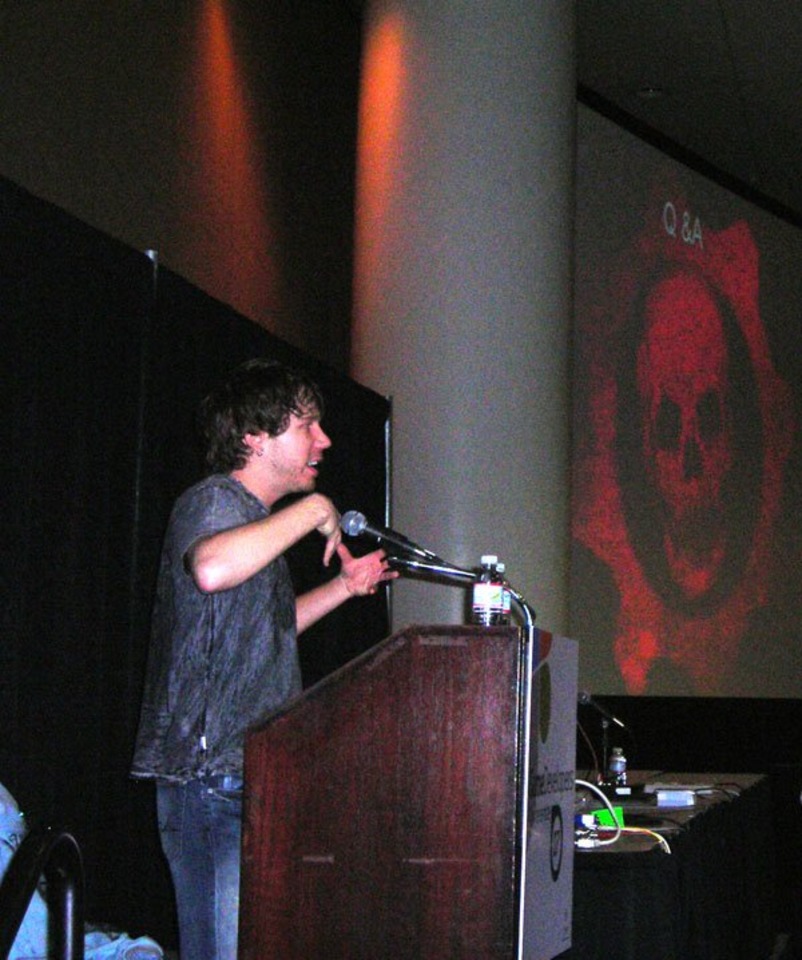GDC 07: Cliffy B disassembles Gears, mentions sequel
[UPDATE] Lead designer chronicles a game's evolution from the first-person shooter "Unreal Warfare" to the best-selling third-person Gears of War; Microsoft insists sequel "still not official."
SAN FRANCISCO--It was a big week for Cliff "Cliffy B" Bleszinski. The Epic Games designer took the stage several times on Wednesday night at the Game Developers Choice Awards, where his game Gears of War won four trophies, including Game of the Year. Given his reputation for letting les bon temps roulez, many wondered if Bleszinski's postceremony celebrations might put a damper on his 9 a.m. presentation the following morning.
But when the hour was nigh, Bleszinski looked surprisingly chipper as the jumped behind the podium. "I know a lot of you were at the bar last night, so I'll do my best to keep you awake," he joked. He then whipped up some excitement by confirming that Epic Games does "intend to do a sequel" to Gears of War. The revelation was hardly surprisingly, though, since it was initially revealed last November when a Microsoft marketing executive said a Gears "trilogy" was planned. [UPDATE] However, despite the fact that the original game has sold more than 3 million copies to date, Microsoft Game Studios has made no official announcement regarding a Gears of War sequel.
Then, Bleszinski went on to talk about Gears' history. The title began as "Unreal Warfare," a more military-themed game inspired by Tribes and Team Fortress. "We thought, let's do something with vehicles and something that involves a lot of territory control," Bleszinski said. He also said they wanted the game be tied in with connection to Unreal Tournament 2004 and would feature an opponent race called the "Geist." However, Epic's "lead cabal" reconsidered when they: a) decided they wanted a separate, single-player-driven game, and b) realized Nintendo had copyrighted the "Geist" as the title for their ghostly GameCube game. His second choice, "The Worm," also didn't stick.
Bleszinski said the seeds of Gears of War were sown by three titles. The first was Capcom's Resident Evil 4, which made an indelible impression on Bleszinski even before its January 2005 release. "I really liked the pacing and the over-the-shoulder view," said the designer.

The second game was Namco's 2004 shooter kill.switch. Though it had much less success critically or financially than Resident Evil 4, Bleszinski felt "it had the best cover system at that time." He felt that incorporating a similar cover system would really change the pace of Gears and set it apart from other shooters.
Another inspiration was the classic arcade game Bionic Commando. In it, players must shoot a grappling hook to ascend from platform to platform vertically. Bleszinski thinks Gears has the same mechanic--jumping from cover point to cover point to advance--on a horizontal axis.
Another interesting tidbit was that Gears started out as a first-person shooter. However, after seeing the impressive graphics of the first Unreal Engine 3 demo, Bleszinski and the rest of the project's lead cabal decided "it would be a crime not to see" the game's hero, who would eventually be named Marcus Fenix. Bleszinski said seeing Fenix so up close that you could see him issue orders and even notice the scar on his ear would make players associate with the character more.
Speaking of viewpoints, Bleszinski went on a mini-rant about how badly he feels the camera is positioned in most third-person shooters. "My big pet peeve...is when I see the [main] guy blocking the line of sight," he said. Once again he said that RE4's over-the-shoulder camera angle, which always faced the enemy, was a big influence on Gears.
Gears of War's design team also worked in a few camera tricks to play with players' perceptions. Bleszinski's concept behind the camera views was "freedom at a trade-off." When a player gets to cover, his field of view widens. However, when performing the so-called "Roadie Run"--which was inspired by the hunched onstage gait of rock-concert technicians--the field of view gets much narrower.
When the player is running, the camera view also gets much shakier; Bleszinski said he wanted it to look like "CNN-type camera." This was a trick to make players think they were moving faster than they really are, since the "Roadie Run" is just 1.2 times quicker than Fenix's regular gait. He said the shaky-cam was just one of many cinematic tricks used in Gears. "The audience has 70-plus years of film-viewing experience, so they can pick up on filmic cues," Bleszinski said.
Some of the more interesting things about Bleszinski's speech were his descriptions of features that weren't included in Gears of War. One concept was called "combat cash," a system that would let players "scoop up the spoils of war" and buy new items on the battlefield--a system (again) reminiscent of Resident Evil 4's mysterious "What are ya buyin'?" merchant. After consideration, though, the lead cabal felt the feature would take away from the game's "pure action" dynamic.

Another system that didn't make the cut was the "morale meter." This system would have seen Fenix's squadmates become more and more disheartened the longer they were pinned down by Locust gunfire. If the group did not advance, a squad member would eventually "put a gun in his mouth." Again, the feature was cut, as the leads felt that it would be too disheartening for a player if his or her squad started committing mass suicide during an already tough level.
Lastly, Gears was also supposed to have a much more complex "Orders System" to let players direct their squads. "We realized we were not making Full Spectrum Warrior and felt that implementing too much [real-time strategy] would take away from the central action element," Bleszinski told the crowd.
Got a news tip or want to contact us directly? Email news@gamespot.com
Join the conversation